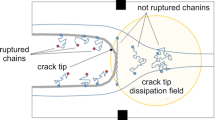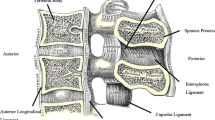Abstract
It is shown that the R-curve of flexible materials can be determined using a monotonic loading of a single trouser tear specimen. The load-displacement records of trouser tear specimens are analyzed based on the locus method which determines the critical J-integral value (J c)) using the locus line of crack initiation points on load-displacement curves of specimens which differ only in initial crack length. Based on this analysis, it is shown that the crack resistance (R) during crack growth including crack initiation and steady state crack propagation can be expressed in terms of quantities that are directly related to the load-displacement plane, and that R can be simplified to a linear function of load. It is also shown that the crack growth (C) can be expressed as a linear function of load-point displacement. The load-displacement record of trouser tearing is then converted to an R-curve simply by changing the scale on each axis. The effectiveness of this method is illustrated experimentally by constructing the R-curve directly from the load-displacement record of a trouser tear specimen made from a thermoplastic rubber sheet.
Résumé
On montre que l'on peut déterminer la courbe R relative à des matériaux flexibles en recourant à un essai charges-déplacements obtenus sur des éprouvettes d'arrachment en se basant sur la méthode des lieux, qui permet de déterminer la valeur critique J cde l'intégrale J en utilisant la ligne des lieux des points d'amorçage relevés sur des courbes charges-déplacement relatives à des éprouvettes qui ne différent que par la longueur initiale de la fissure.
En se basant sur cette analyse, on montre que la résistance à la fissuration au cours de la phase d'amorçage et de croissance stable de la fissure, peut être exprimée en fonction de quantités directement liées à la relation charges-déplacements, et que R peut être ramené de manière simplifiée à une fonction linéaire de la charge, On montre également que la croissance C de la fissure peut être exprimée comme une fonction linéaire du déplacement du point de mise en charge.
L'enregistrement charges-déplacement d'un essai d'arrachement se trouve être convertible en une courbe R par un simple changement d'échelle des axes.
On illustre l'utilite de cette méthode en construisant expérimentallement la courbe R directement au départ d'un enregistrement charges-déplacements d'une éprouvette d'arrachement réalisée dans une feuille de caoutchouc thermoplastique.
Similar content being viewed by others
References
J.M. Krafft, A.M. Sullivan and R.W. Boyle, in Proceedings of the Crack Propagation Symposium I, Cranfield (1961) 8–28.
D. Broek, Applied Materials Research 4 (1965) 188–189.
D. Broek, Elementary Engineering Fracture Mechanics, 4th rev. ed., Martinus Nijhoff Publishers (1986) 130–136, 202–208.
J.R. Rice, Journal of Applied Mechanics 35 (1968) 379–386.
J.A. Begley and J.D. Landes, ASTM STP 560 (1974) 170–186.
J.W. Hutchinson and P.C. Paris, ASTM STP 668 (1979) 37–64.
Y.W. Mai and M.I. Hakeem, Journal of Materials Science 19 (1984) 501–508.
M. Gomina, D. Themines, J.L. Chermant and F. Osterstock, International Journal of Fracture 34 (1987) 219–228.
J.R. Rice, P.C. Paris and J.G. Merkle, ASTM STP 536 (1973) 231–245.
J.A. Begley and J.D. Landes, ASTM STP 536 (1973) 246–263.
J.G. Merkle, ASTM STP 536 (1973) 264–280.
J.E. Srawley, International Journal of Fracture 12 (1976) RCR 470–474.
R.S. Rivlin and A.G. Thomas, Journal of Polymer Science 10 (1953) 291–318.
A.J. Kinloch and R.J. Young, Fracture Behaviour of Polymers, Elsevier Applied Science Publishers (1983) 97–105.
B.H. Kim and C.R. Joe, International Journal of Fracture 34 (1987) R57-R60.
B.H. Kim and C.R. Joe, Polymer Testing 7 (1987) 355–363.
B.H. Kim and C.R. Joe, Engineering Fracture Mechanics 30 (1988) 493–503.
Y.W. Mai and B. Cotterell, International Journal of Fracture 24 (1984) 229–236.
B.H. Kim and C.R. Joe, Engineering Fracture Mechanics 34 (1989) 221–231.
H. Liebowitz and J. Eftis, Engineering Fracture Mechanics 3 (1971) 267–281.
Author information
Authors and Affiliations
Rights and permissions
About this article
Cite this article
Joe, C.R., Kim, B.H. A method to determine the R-curve of flexible materials using a monotonic loading of a single trouser tear specimen. Int J Fract 44, 15–26 (1990). https://doi.org/10.1007/BF00012549
Received:
Accepted:
Issue Date:
DOI: https://doi.org/10.1007/BF00012549




